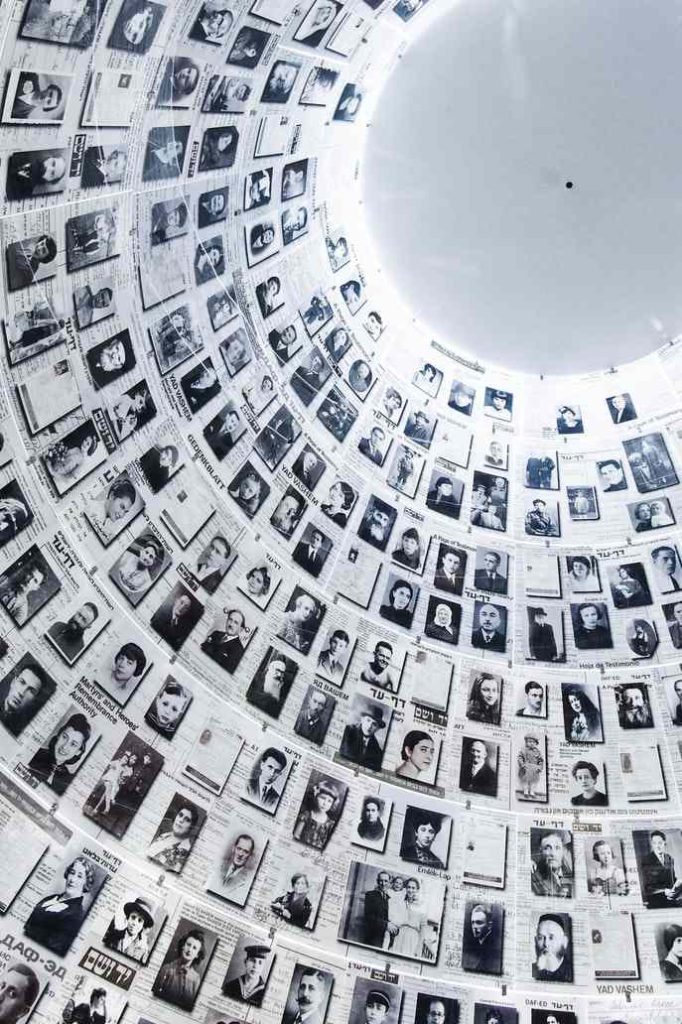Cred: @xaze
The Blue Skies Project began in 2012 when Bulgarian photographer Anton Kusters visited Auschwitz in memory of his grandfather. Due to the overwhelming feeling the camp created in Kusters, all he could do is take a photograph of the sky.
He realized that there was no way of knowing which concentration camp his grandfather would have been taken to, so he decided to embark on a nearly six-year journey, visiting all of the known camps across Europe, taking a photograph of the sky in each place. It was exhibited in The Photographers Gallery in 2020. In total, 1078 polaroids of the sky above each Nazi concentration camps were taken.
Each photograph is blind-stamped with the estimated number of victims and the camps’ GPS coordinates. The complete work can be found at the United States Holocaust Memorial Museum in Washington, D.C., and is paired with an audio reel, created by Ruben Samama, which plays for roughly thirteen years, emitting a single tone per victim, in memory of every known victim. This soundtrack plays in real-time by retracing the timeline of the opening of the first concentration camp to the closing of the last one.
The Skies
The Blue Skies Project contains a beautiful composite of the different blue hues of the sky above each known concentration camp. When looking at the images individually, the audience can see roughly when the photos were taken and in what conditions.
Some photographs are bright blue, suggesting they were taken sometime in the daytime, some are dark blue and nearly black, suggesting they were taken at night. Different cloud patterns can also help us imagine what the weather conditions were during the time a photograph was taken. When looking at the piece in its entirety, there is an overwhelming amount of blue in different shades, perhaps symbolizing the overwhelming feeling Kusters had when he first visited Auschwitz.
Materials
Compared to other works that were entered into the Deutsche Börse Photography Foundation Prize (2020), The Blue Skies Project uses a simple polaroid camera to take one image of the sky above the photographer. Unlike the other projects, there is no staging or editing that takes place, it is a simple image of something we see every day.
The Blue Skies Project is the only Deutsche Börse Photography Foundation Prize (2020) nominee that includes an auditory experience as well as being the single artwork that is composed of only photographing the same thing repeatedly (the sky).
What makes these raw, unedited, otherwise monotonous images so powerful is that they are blind-stamped with numbers that represent the lives lost in each camp and are paired with a soul-stirring soundtrack that materializes and gives voice to those lost in the Holocaust.
The photographs themselves would not be powerful without the unseen background of each image. Behind each image stands a location that contributed to one of history’s greatest tragedies, the genocide of the European Jews during World War II. The stamped numbers represent the estimated number of victims as well as the coordinates of each concentration camp.
Audio
Perhaps the most powerful part of this artwork is the haunting audio track. It plays a single tone for each known victim, and spanning 4432 days, this soundtrack gives a voice to the lives lost during the tragedy of the Holocaust. The photographs alone overwhelm the audience’s visual senses with the plethora of blue hues and the bright, sharp contrast of the polaroid images, however, the story of the photographs is what makes the composite images of the Blue Skies Project so moving and overwhelming to look at.
The memory of the Holocaust comes alive when you read the numbers stamped on the images, and paired with the soundtrack, it doesn’t only stir spectators visually and emotionally but also overwhelms them auditorially, making it the trifecta of visual, emotional, and auditory stimulation.
Meanings and Interpretations

Cred: @eelco_bohtlingk
According to Kusters, The Blue Skies Project is a representation of the horrible trauma that has been seemingly pushed aside, and almost forgotten, in recent years. This project aims to reignite the memory of this horrific historical event. It is about remembering the trauma collectively and not forgetting all of the individuals who lost their lives during the Holocaust.
In addition to Kusters, there have been many others who have reflected on this artwork, for example, art and design editor Rachel Gould wrote about this project and interpreted it as “carrying the weight of genocide through photography”. She also mentioned that the glossy sheen film of a Polaroid picture allows the viewer to literally see their reflection in the image, making the audience part of the exhibition.
Martin Barnes, the Senior Curator of Photographs at the Victoria and Albert Museum in London, also spoke extensively about his thoughts on The Blue Skies Project.
He connected the idea that a person’s associations with blue skies typically resonate with “freedom, expansiveness, and the spiritual realm”, and Kusters’ collection creates a harsh dissonance between those positive and elated feelings and the horrors that took place behind those photographs. The choice of photographing only the sky and nothing else at the concentration camps created an “empty” image giving way for self-reflection.
Both Gould and Barnes, as well as many others (including Kusters) conclude that the main purpose of this piece of art is to remember the trauma that the Holocaust created. The simplicity of this piece allows anyone to think about and reflect on what happened during World War II.
The numbers of the lives lost blind-stamped on the images, paired with the haunting audio, imprints the severity and the pain of the Holocaust into the audiences’ minds, bringing it to life.
Today, Kusters takes his polaroids and exhibits them across the world in different museums and art galleries. Creativity is one of the most lucrative skills you can have and it is a skill for any job, but it seems to only be utilized by artists these days.
When it comes to art, it is easy to misinterpret things or get lost in the dozens of interpretations behind a single piece, however, when it comes to The Blue Skies Project, the message is clear. It is a haunting, yet beautiful compilation of images. At first glance, all you see is blue skies, but once you take a closer look and read the death tally on each image, the horror of this tragic event in history hits hard.
Apart from this if you are interested to know about Firefighting Foam then visit to our health category

